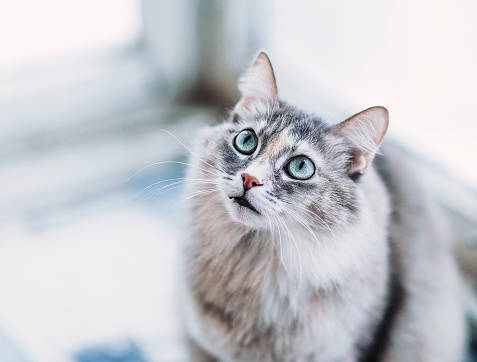Measurement of intraocular pressure is carried out if glaucoma or uveitis is suspected. The procedure is performed with a special device, does not take much time and is painless for the cat.
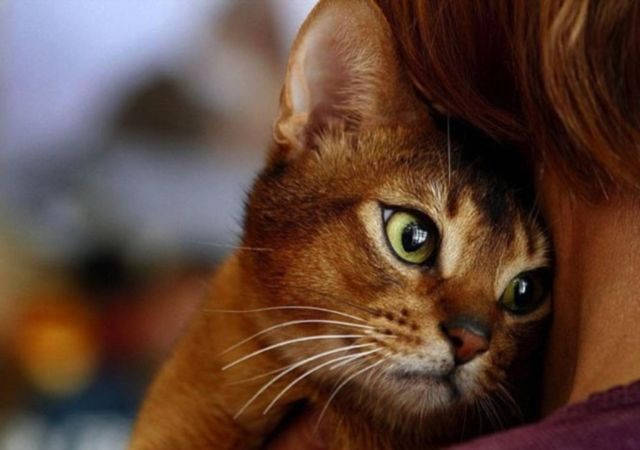
- Pus in a cat's eyes – how to treat?
- Treatment of purulent eyes in a cat
- Injuries
- Parasitic diseases
- Pus from a cat's eyes
- Treatment in a veterinary clinic
- Diagnosis
- Treatment, prognosis
- Types of eye discharge
- What to do first in case of purulent eyes
- What to do in the home
- Preventative measures
- Interesting topics
- What else to read:
- Types of infusions and solutions
- The choice of ointments and how to apply them
- How to drop the drug
- Use of therapeutic ointments
- Possible complications
- Preventive measures
- Interesting topics
- What else to read:
Pus in a cat's eyes – how to treat?
If a cat's eyes have been pus for a long time, and the owner does not carry out any treatment, the condition of the pet may worsen. In addition to the fact that pus gives a lot of discomfort, depending on the cause, complications will develop.
In order to make a diagnosis, the pet should be taken to a veterinary clinic or call the doctor at home. You will need to tell the specialist how long ago the problem arose and about all the symptoms you noticed. You will also need to recall if the pet has suffered from any eye disease, chronic ailments, and if the pet has any allergies.
The vet will, in turn, examine the frequency and consistency of the discharge, visually identify injuries and possible foreign objects in the mucosa. Based on the interview and examination, the veterinarian will determine the cause that caused the pus from the cat's eyes, diagnose it and prescribe the appropriate treatment. In cases where the doctor has difficulty making an exact diagnosis, an x-ray of the skull and ultrasound of the affected eye are prescribed.
Treatment of purulent eyes in a cat
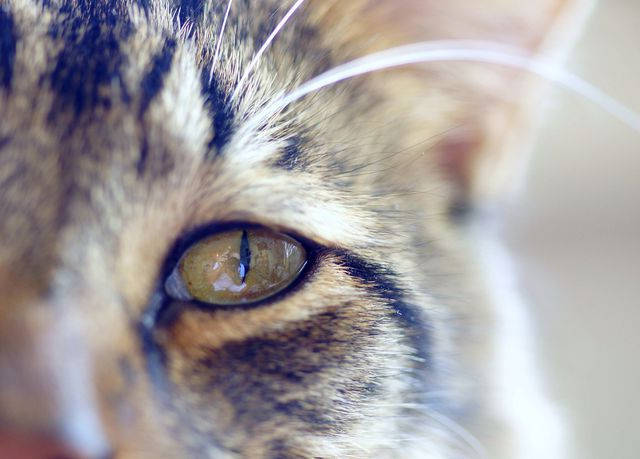
When a cat's eyes are pusy, treatment will be prescribed depending on the cause. There are a number of ophthalmologic drugs that will help combat the ailment. Most often, veterinarians prescribe eye drops for cats.
- Bactericidal or antiseptic. They help with pus only in the initial stages of the disease. This may be Lacrican or Ophthalmosan. The former have polysept as an active ingredient. In addition, the composition includes menthol and anesthesin, which reduces the discomfort.
- Antibacterial. They are prescribed in cases of bacterial infection. Effective antibacterial drops are considered: Lacrimin aseptic (treats chronic eye disease), Ciprovet (effectively treats chlamydia), Dekta-2 (relieves inflammation and eliminates allergy symptoms).
- Immunomodulatory. Ophthalmic drops, which have an immunomodulatory effect, are prescribed for viral infections and inflammatory reactions. In veterinary medicine, Maxidin and Anandin are used. Maxidin strengthens the immune system and suppresses the development of viruses, while Anandin, in addition to boosting the immune system, relieves inflammation and accelerates wound healing.
It is important to use the drops according to the instructions. The dose should never be exceeded. The liquid must get into the eye sack. Before using the drug, the eye should be rinsed and cleaned of crusts.
Flushing fluid can be purchased at any veterinary pharmacy (e.g., Medkinos or Lakrimin) or you can make your own at home.
- Chamomile Decoction. Add 1 tbsp of chamomile to a glass of boiling water and simmer for 3-4 minutes. After letting it infuse for 15 minutes, soak a cotton pad in the warmed liquid and gently rub the pet's eyes.
- Strong tea infusion. Boil 2 sachets of black or green tea in a glass of boiling water. If you don't have tea bags, you can substitute 1 tbsp. leaf tea. Leave to infuse for 10 minutes, then soak a cotton pad or cotton tourniquet, squeeze out and rub into the eye corners.
- Saline solution. Dissolve 1 tsp. of salt in 0.5 ml of hot water. Let cool down to room temperature and apply.
Injuries
The danger is not the primary injuries but the secondary infection of the affected surfaces with pathogenic microorganisms. Festering occurs, preceded by inflammation, hyperemia, swelling and heavy tearing.
Injury to the animal, if not treated promptly, is complicated by infection, as evidenced by purulent discharge. A veterinarian will be able to help with the disease. He will conduct a series of tests and develop an adequate scheme of therapy.
Parasitic diseases
Helminths, during their life activity, poison the entire body. Inflammation of the conjunctiva, cornea or eyelids may be evidence of a parasitic infestation. In addition, specific helminths may be the cause of purulent discharge from the eyes, which is caused by teliathiasis. Parasite larvae enter the eyes with insects or are carried by the wind. The parasites are localized in the space between the eyelid and the eyeball. Complications of thelaziosis are rare in cats, but the parasites irritate the mucous membranes of the eyes, opening the gates to other infections.
A large volume of mucous secretion is the first alarm bell for the cat owner. Over time, the pathological process worsens and pus begins to appear from the eyes.
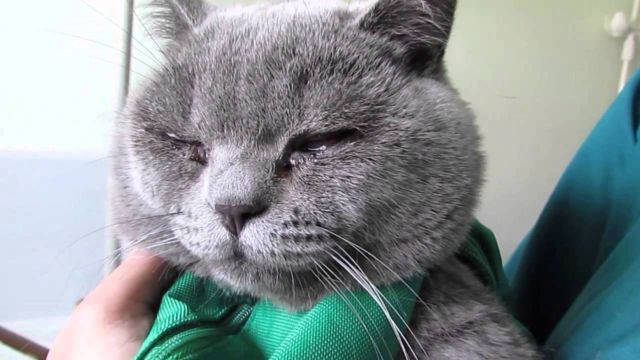
Due to the high volume of incoming questions, free veterinary consultations are temporarily suspended.
Pus from a cat's eyes
As soon as a pet owner notices the following signs, it is necessary to seek help at a veterinary hospital:
If there is no possibility to go to the vet urgently, you can try to rinse the pet's eyes at home, alleviating the symptoms. For this purpose, folk remedies are used to reduce inflammation, relieve itching and remove pus:
- Infusion of chamomile. The infusion is prepared at home. Take dried chamomile flowers – 1 tbsp and pour 200 ml of boiling water. Allow to infuse for 15 minutes. Rub the affected area gently with a cotton pad soaked in the infusion.
- Brewing strong tea. Infuse 2 tea bags or 1 tbsp. of black tea in 200 ml of boiling water. The infusion may be left to infuse for 15 minutes and the resulting infusion may be applied to a cotton pad, squeezed out slightly and wiped from accumulated exudate in the eye corners.
- Saline solution. Dissolve 1 teaspoon of salt in 500 ml of hot water. The solution is then cooled down to a comfortable temperature, moisten a gauze (recommended) or cotton pad and cleanse the animal's eyes.
Treatment in a veterinary clinic
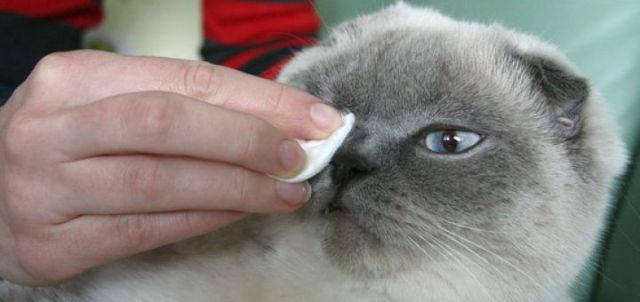
Noticing the characteristic pathological changes in the eye area of the cat, it is not recommended to delay a visit to a veterinarian. The specialist will conduct a general clinical examination and prescribe a number of tests. Obligatory for diagnosis are:
Based on the findings, the doctor will develop a therapeutic regimen. Depending on the factors that contributed to the development of the disease, the treatment regimen will differ.
If the cause of the purulent exudate is mechanical trauma, the affected area is thoroughly cleaned using an antiseptic. Then the eye is washed with a solution of manganese solution and special drops with an antimicrobial effect are put into the eye.
In the case of diagnosed blepharitis, it is necessary to identify the factor that provoked the inflammation. First of all, the cat is prescribed a balanced diet, since quite often the cause of blepharitis is a lack of vitamins in the body. In addition to eye drops, the animal is recommended to put a special ointment with antibiotic and anti-inflammatory action. Severe pain in the animal is eliminated by performing a novocaine blockade.
A special place is occupied by conjunctivitis of purulent and phlegmonous type. When they develop, the veterinarian develops a comprehensive treatment. In addition to obligatory eye washings several times a day, antimicrobial ointments are prescribed. The affected area is anesthetized with a novocaine block.
Drops used by veterinary ophthalmologists come in the following types:
- Antiseptic. Well cope with suppuration of the eyes in the earliest stages of the pathology. Lakrikan and Oftalmosan means are prescribed. In addition to antiseptic action, the drugs have a mild analgesic effect.
- Antimicrobials. Obligatory when diagnosed with serious bacterial infections. Drops that allow you to fight diseases of the chronic type in the eye area – Lacrimin and Dekta-2. They are used to relieve inflammation and signs of allergies.
- Immunomodulatory. Drops used in veterinary ophthalmology to combat viral infection and inflammation should have an immunomodulatory effect. Maxidin and Anandin drops have proven to be excellent. They allow not only to strengthen the body's response to the introduction of viruses, but also have anti-inflammatory properties.
Diagnosis
First, the doctor examines the animal for injuries, collects information about its state of health, finds out what chronic diseases there are. Next, to make a diagnosis, the veterinarian needs to perform a number of diagnostic tests, including examining the frequency and consistency of the discharge.
In some cases, an ultrasound of the affected eye and skull x-rays are necessary.
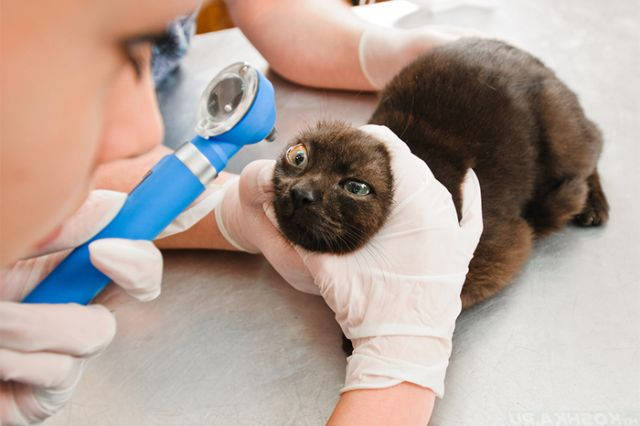
Treatment, prognosis
There is no single treatment for pus-filled eyes in a cat. The veterinarian develops an individual scheme depending on the disease, with the elimination of which the problem of pus discharge will disappear.
Be sure to prescribe eye drops and ointments, which are divided into three groups:
- Antiseptic (bactericidal). The composition includes polysept, anesthesin and other components to help eliminate painful sensations. The most effective drugs are considered to be such as Oftalmosan, Lakrikan.
- Antibacterial. These are indicated for bacterial infections. Ciprovet, Dekta-2, Lakrimin aseptic have proven themselves well. They relieve inflammation and successfully treat chronic diseases of the organs of vision.
- Immunomodulatory. They are prescribed for inflammatory processes and viral infections. As a rule, the veterinarian prescribes Anandin and Maxidin. They strengthen the immune system, accelerate wound healing and inhibit the activity of viruses.
The medication and dosage are set by the veterinarian. Before applying the ointment or drops, the eyes should be cleaned of pus and crusts with a special disinfectant solution.
Types of eye discharge
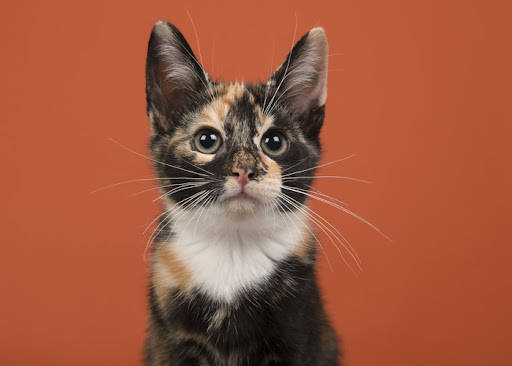
A healthy pet discharges transparent liquid secretion in small amounts from its eyes. Thanks to such secretions the eye is cleaned from dust and other small environmental pollutants. During hygienic procedures, the cat gets rid of residual secretions on its own.
If the color and character of the eye discharge changes to brown, greenish-yellowish or other shades other than normal, you should closely monitor the cat's behavior: perhaps his health requires the help of a specialist.
- Brown discharge with an admixture of pus is a signal of bacterial infection. If festering eyes are followed by other symptoms, such as lethargy, nasal discharge or loss of appetite, see your veterinarian immediately;
- Profuse and thick, transparent discharge is often a symptom of a viral infection;
- Dark, pus-free discharge may occur if the tear ducts are malfunctioning;
- If the discharge looks like normal tears, the cat is probably allergic. Allergies can be recognized by swelling and redness of the eyes.
A number of tests and examinations are necessary to make an accurate diagnosis. Treating a cat without a doctor's recommendation, based only on the color and nature of the discharge, is dangerous to the cat's health.
What to do first in case of purulent eyes
If your cat has purulent eyes, you should contact your veterinarian immediately. If an appointment is not available promptly, a veterinarian can be consulted remotely to advise on safe eye washings.
Small pore discharges can be removed with saline or chlorhexidine solution, but Vetericin is also a good solution: it has a disinfectant effect and helps to reduce inflammation gently. To remove dirt, soak a cloth or tampon in room temperature solution and gently remove any residual secretions from the outer corner of the eye to the inner corner. Do not move in the opposite direction: contamination can get into the pet's eye and cause inflammation.
What to do in the home
The owner must create the most comfortable conditions for the sick pet and strictly follow the veterinarian's instructions. Under no circumstances should self-treatment, as it can aggravate the situation.
Some folk methods have a place in conjunctivitis, but they should not replace the conservative treatment. It is acceptable to use them in combination with medications.
Most commonly, decoction of chamomile and calendula is used at home to wash the eyes. Mixture of dried plants should be taken in 1 teaspoon each, covered with boiling water, left to cool and allowed to stand. Rub your eyes with this disinfectant decoction at room temperature 2-5 times a day.
Dropping willow decoction gives a good effect. Willow is an antibiotic of natural origin. To obtain a medicinal infusion take 2 tablespoons of dried and shredded twigs, pour a glass of hot water, boiled for 5 minutes. Then cool and insist. To reduce inflammation and eliminate germs to drop or wipe the eyes should be 3 times a day.
You can also wipe your eyes with Chlorhexidine solution. The drug is well tolerated by cats, gives no side effects, effectively disinfects and destroys some types of fungi.
Furacilin solution gives a good result. However, the correct dosage with a small volume is difficult to calculate correctly. Veterinarians do not recommend using a solution of manganese, as it severely dries the mucosa and can provoke a burn.
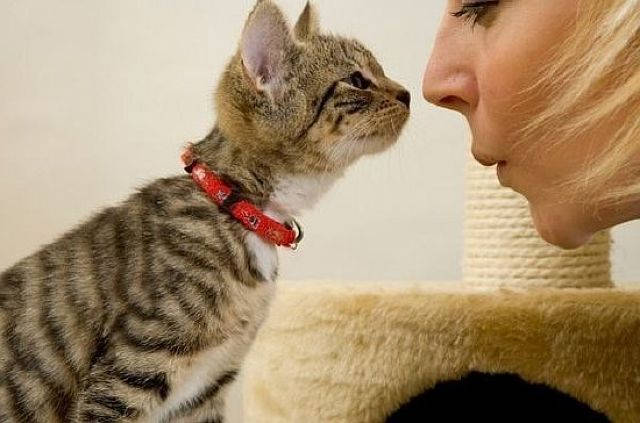
A cat with conjunctivitis must be isolated from other pets. The disease is contagious and can be transmitted to humans. When caring for a four-legged pet, you need to observe personal hygiene, wash your hands with soap and water or treat them with a disinfectant solution.
Preventative measures
Like any disease, conjunctivitis can be prevented. It is enough to observe the simplest preventive measures, known to every owner:
- Keep hair out of the eyes when combing;
- Keep household chemicals out of reach;
- carry out timely anti-parasite treatments and vaccinations;
- Limit the dog's walking and contact with stray animals;
- Keep the pet in a warm, draught-free room;
- Visit the veterinarian once a year for a routine checkup;
- Strengthen the immune system with multivitamin complexes;
- Perform more frequent wet cleaning and airing of the room.
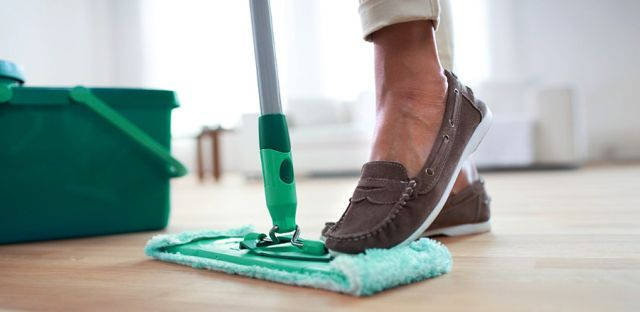
If a pet gets a wound near the eye, it should be treated immediately with a disinfectant solution. If this is not done, the infection can affect the organ of vision.
At the first signs of conjunctivitis you should not delay a visit to the veterinarian. The earlier treatment begins, the better the chances of a favorable prognosis.
Interesting topics
What else to read:
- Why do cats like boxes so much?Pet owners know that no self-respecting cat.
- Cat constipation: the problem and its solutionSurprisingly, our little brothers suffer from the same diseases that.
- If a cat molts a lotContents of the article Moulting is a normal process. Thanks to her there is a gradual.
- Poodlecat: an unharmful inheritanceHave you ever heard of a poodle cat? The authors of the articles: the team at the Belanta Clinic.
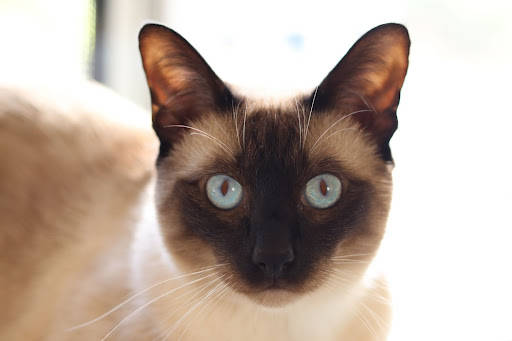
Types of infusions and solutions
Eye solution can be purchased in the pharmacy, as well as prepared by yourself.
- Chamomile infusion. One tablespoon of dried flowers dilute in a glass of steep boiling water. Insist for 30 minutes.
- Decoction of strong tea. It is desirable to use whole leaves and distilled water.
- A solution of table salt. Take 1/2 teaspoon of salt per liter of distilled water. The mixture is brought to a boil. Not suitable if you have an allergic reaction.
- Lakrimin or Medkinos solutions, which are always available in the pharmacy at an affordable price.
The choice of ointments and how to apply them
For the best effect, it is recommended to use ointments. As a rule, tetracycline ointment (1%) is used.
- First, purulent secretions from the eyes and nose are removed. Carefully wash the inflamed areas with a cotton disc soaked in the tincture or solution.
- To enhance the effect, the ointment is heated to room temperature in advance.
- Slightly pull away the lower eyelid of the cat, apply the ointment to its inner surface, laying the latter with a special spatula.
- The eyelids are closed, massaging in circular movements for better distribution of the ointment on the surface of the swollen eye.
- Remove the excess with a cotton pad.
How to drop the drug
Before applying the drops, you must rinse the cat's or kitten's eyes with a sterile bandage, cotton pad. After rinsing:
- Lay the kitty on its side, hold its head with one hand and lift it slightly. Wrap it in a sheet or blanket to prevent the cat from tearing out.
- Gently ajar the sore eye and put the medicine in it. Hold the pet's muzzle during the procedure.
- Make sure that the drops spread evenly over the surface of the eye. Excess medication can be blotted with a sterile napkin.
The duration of use of the drops depends on the type and severity of the disease. Usually, they are put into drops from 2 to 6 times a day, and the full course of treatment can take up to three weeks.
Use of therapeutic ointments
Antibacterial ointments such as tetracycline (1%) are used to treat inflammatory eye conditions. The ointment is applied to the affected eye, usually under the lower eyelid. The technique of application is similar to that of eye drops.
It is important to fix the pet well, carefully apply the ointment and gently massage the eyelid area so that the drug is well distributed.
It is best to apply the ointment not by hand, but with a special glass wand with a round tip. This device can be purchased at pet stores or veterinary drugstores.
Possible complications
If you refuse to go to the clinic and self-selection of drugs for the pet, the disease becomes neglected and dangerous for its recurrences. Fungal and parasitic skin lesions (mostly on the head) are possible, worsening the condition of the pet.
With the neglected form of infectious diseases and weak immunity of the kitten, the pet will not be able to survive.
With eye disease and unskilled care, the lesion affects the deep layers of the eye. In this case, the pet is at risk of loss of vision.
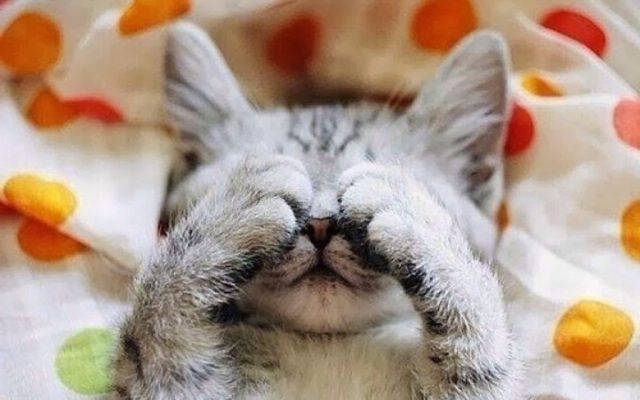
Preventive measures
- Annual vaccination of the pet at a veterinary clinic. Vaccination will protect against common infectious diseases, the vaccination calendar can always be checked at the veterinary clinic.
- Avoid contact between the animal and the owner's outer clothing and shoes because of the potential threat of viral infections.
- A balanced diet and vitamin supplements will form a strong immune system for the kitten. We recommend discussing a proper nutrition menu with a veterinary specialist.
- Regular hygiene procedures for kitten's eyes, especially in breeds that are prone to their diseases.
- When introducing new foods, carefully monitor your kitten's health and promptly exclude the product that raised suspicions as an allergen.
- Keep household chemicals out of kitty's reach.
If health deteriorates, you should not leave your kitten without qualified medical care.
An effective treatment and quick recovery will help the kitten return to its normal lifestyle in the shortest time possible and continue to bring joy to its owners.
Interesting topics
What else to read:
- How to quickly train a kitten to go to the litter boxEvery owner wonders how to train a kitten to the litter box, because.
- Kitten Litter Treatment at HomeArticle Contents Kittens, as well as cats "in age", more than others.
- If a kitten has diarrheaArticle Contents When a small fluffy lump comes into the house, happiness.
- Choosing a kitten for the houseArticle Content When deciding to take a furry friend into the house, you need to understand.
